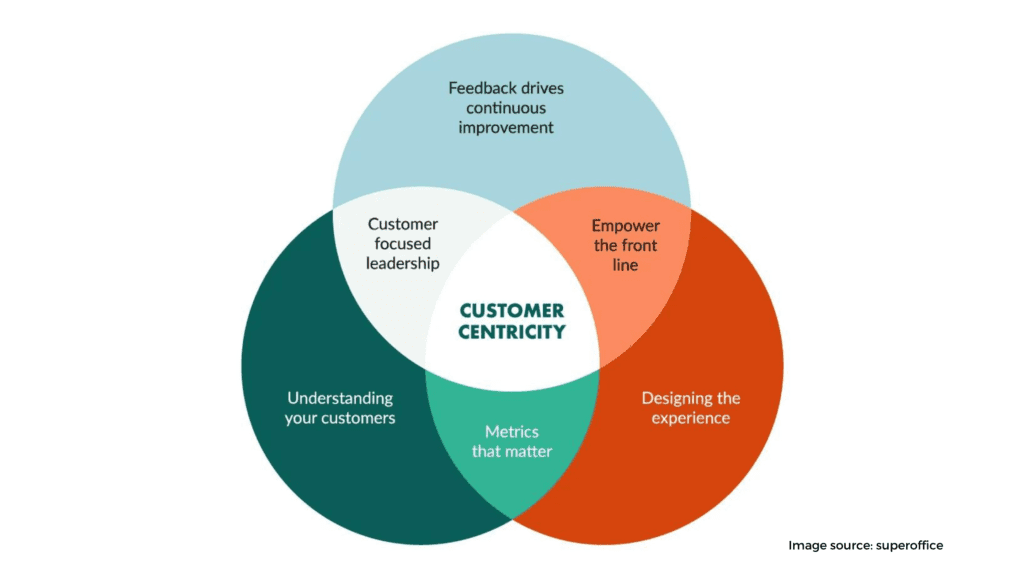When was the last time a business fully addressed your wants and needs as a customer? In today’s world, it can be hard to find a company that puts the customer first, but those that do are typically the most successful. Crafting a customer-centric marketing strategy is the key to success in any business.
It’s critical for your firm to add value at every stage of the client journey and satisfy their requirements in order for consumers to become advocates. Creating a good customer-centric marketing plan is one approach to do this.
What is customer-centric marketing?
Customer-focused marketing is the process of placing the customer’s needs and interests first in each interaction with your firm, such as delivery, promotion, advertising, and more.
Customer-centric marketing is the process of creating a customer experience that satisfies your consumers enough to keep them loyal and encourage them to tell others about their experiences. To implement client-centric marketing in your company, first ask yourself this question:
- What methods are they using to get in touch with your company? Is it on social media, the internet, email, phone, or some other channel?
- Is value being offered in each of these channels?
- What can be done to improve the customer’s experience at each touchpoint?
Customer-Centric Marketing Examples
One of the most popular kinds of marketing is customer-centric. Several firms have used this method to good effect. These businesses include:
1. Starbucks
Starbucks’ Starbucks Reward Loyalty Program is one of the most well-known successful customer-centric marketing methods. This program provides a variety of benefits, including special discounts and free refills on brewed coffee for customers on their birthdays. Customers can, however, order and pay ahead of time through the app.
Customers who are rushed for time can now schedule their items for pickup, avoiding queues and variable wait times.
Forbes reported that Starbucks credited 40% of total revenues in 2019 to its loyalty program. Users of the Loyalty Program’s app were 5.6 times more likely to go to a Starbucks every day, according to Forbes.
2. Nordstrom
Nordstrom, a luxury department store chain, wanted to enhance the customer service and product discovery experience by incorporating a more streamlined and customized shopping journey. The Nordstrom Analytical Platform was used to do so. The system is based on AI technologies that handle things such as inventory management and shipment, as well as sending purchase orders to the nearest store.
The firm also developed fashion maps, in which the AI utilizes natural language conversations, pictures, and data gathered from social media to forecast consumer preferences. Customers may get tailored offerings and selections via the Nordstrom Analytical Platform’s Looks feature, storyboards, and other features thanks to AI.
3. Bacardi
Bacardi wanted to pique people’s interest in the brand’s new single-malt whiskies in the UK and Germany this past year. Understanding consumers in that demographic are typically drawn to luxury, Bacardi teamed up with Amazon to develop a live whisky tasting available at their leisure via Amazon Prime Video.
The spirits company, Glenfarclas, has created a Single Malt Discovery Collection of three whiskies for tasting. The collection was accessible on Amazon in the UK and Germany, and purchasers received access to the live-streamed tasting in return. Customers could interact with the host during the live broadcast by visiting a customized landing page on Amazon. More than 500 questions were submitted, and sales increased on Amazon as a result of this initiative.
Tips for Creating a Strong Customer-Centric Marketing Strategy

Crafting a customer-centric marketing strategy for the first time can be daunting, but it doesn’t have to be. Here’s how to get started:
1. Get Leadership Involved
To assist guarantee the success of any new plan, it’s critical to enlist the help and support of senior leadership. If senior management values clients at every channel and contact, it will inspire others in the company to do so as well. Hosting frequent meetings to educate leadership on customer-centric marketing, discuss upcoming campaigns, and brainstorm innovative ways to market the business is a good way to get them on board.
2. Learn About Your Customers
Gain a better understanding of your customers by doing some of the following:
- Conduct surveys with clients to evaluate the service/product, the company’s strengths, areas for improvement, and how they interact most with the brand.
- Have one-on-one talks with current and former consumers to find out what their experience has been like, why they choose to stick with the firm, or why they departed. You may also inquire about any modifications that would have kept them loyal.
- Use data gathered from analytics tools to track customer behavior.
- Check out what people are saying about your company on social media and/or enable Google Alerts so you can keep track of what’s going on. If consumers frequently vent their frustrations about how difficult it is to navigate your website on Twitter, that could be an indication that the site needs to be updated. You may also assess the type of material that your customers want to see on social media sites. Customers on Twitter enjoy having their queries answered or reading vital announcements, while followers on TikTok enjoy behind-the-scenes movies.
- Read customer emails and listen in on conversations to determine how clients with your firm are interacting.
3. Add Value to Every Customer Interaction
Customers, or potential consumers, can be at any point in their journey with your firm, which is why it’s critical to appeal at each touchpoint. Every stage of the buyer’s journey should elicit interest and pleasure, whether they are using social media to get in contact with you, phoning to request assistance with a problem, or nearing the end of purchasing a product/service.
Nordstrom offers custom goods and services based on the client’s activity, and Starbucks has built a system that enables consumers to get their demands met quickly and effectively. The ability of Bacardi to create a virtual, at-home whisky tasting is an excellent illustration of adding value throughout multiple customer interactions. The one thing all of these activities have in common is that they make the consumer experience enjoyable, engaging, and simple.
4. The Value of Customer-Centric Marketing
Customers are increasingly interacting with companies and brands in a non-linear manner. To stay ahead of the ever-changing path, businesses must embrace a customer-centric marketing strategy to establish deeper connections with their consumers and transform them into some of their most vocal advocates.
Conclusion
In conclusion, implementing a customer-centric marketing strategy is essential for businesses in today’s competitive market. By taking the time to learn about their customers, add value to every interaction, and make the buying journey as simple and enjoyable as possible, companies can create lasting relationships with their consumers and benefit from increased sales.
Thank you for reading! We hope this article has given you a better understanding of what customer-centric marketing is and some tips on how to implement it into your own business.






